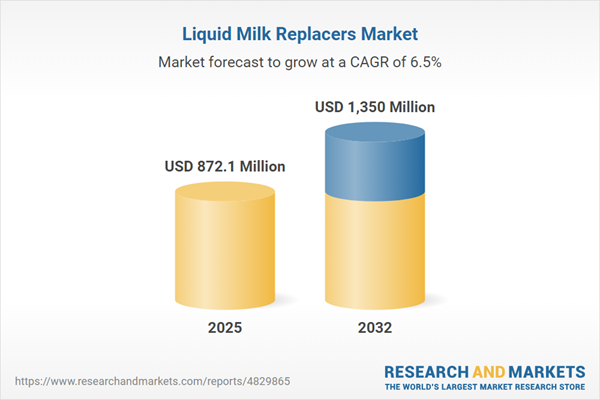Speak directly to the analyst to clarify any post sales queries you may have.
The liquid milk replacers market is evolving rapidly as companies navigate regulatory complexity, technological shifts, and changing production approaches. Senior leaders must respond decisively to streamline operations and ensure competitive positioning in a dynamic sector that directly impacts feed quality and livestock performance.
Market Snapshot: Liquid Milk Replacers Market Size, Trends, and Growth Outlook
The global liquid milk replacers market achieved a value of USD 817.61 million in 2024, with projections indicating growth to USD 872.10 million by 2025 and USD 1.35 billion by 2032, supported by a compound annual growth rate (CAGR) of 6.52%. This steady expansion reflects enhanced focus on optimal animal nutrition, accelerated adoption of digital tools, and industry-wide drives toward greater operational efficiency. Market leaders are adapting quickly, instating robust feeding protocols, strengthening management structures, and advancing compliance to align with rising regulatory standards. Advanced sourcing and logistics solutions are keeping key players agile, fostering resilience in a marketplace influenced by shifting technology and customer demands.
Scope & Segmentation of the Liquid Milk Replacers Market
- Type: Covers both medicated and non-medicated liquid milk replacers, allowing health management choices tailored to regional veterinary guidelines and compliance requirements.
- Source: Includes skim-based, whey-based, and multi-protein blends, supporting adaptability to ingredient availability and local production capacities in various markets.
- Application Stage: Applies across all key phases, from early-life livestock feeding through to weaning, helping producers meet growth and development milestones efficiently.
- Distribution Channels: Utilizes farm retailers, feed mills, supermarkets, veterinary outlets, and digital procurement platforms, expanding access and responsiveness for manufacturers and end-users alike.
- Geographies: Spans the Americas, Europe, Middle East & Africa, and Asia-Pacific, with local farming methods and regulatory climates distinctly shaping usage patterns and purchase decisions.
- Key Companies: Showcases recognized players such as Calva Products LLC, Trouw Nutrition by Nutreco N.V., Liprovit BV, Cargill Incorporated, Alltech Inc., Milk Products Inc., Land O’Lakes Inc., Pet-Ag Inc., Whytes Agri, and Kellihers Feeds. These organizations emphasize transparent sourcing, ongoing investment in nutrition research, and robust risk management strategies.
Key Takeaways for Senior Decision-Makers
- Technology advancements, including micro-encapsulation and enzymatic customization, are enabling better nutrient delivery and supporting higher thresholds for animal health and feed consistency.
- Comprehensive supply chain visibility is essential for traceability, allowing manufacturers and stakeholders to consistently meet evolving regulatory and buyer expectations.
- The diversification of protein sources—such as the integration of plant- and microbial-based options—is boosting raw material flexibility and supporting sustainable sourcing objectives.
- Automated procurement processes and digital inventory management tools are streamlining operational adjustments, essential for organizations aiming to scale quickly and maintain responsiveness amid market expansion.
- Collaboration between research, production, and distribution partners plays a central role in achieving progress on sustainability targets and compliance with emerging regulatory landscapes.
Tariff Impact: Navigating Effects of Recent U.S. Trade Policy Changes
Recent tariff adjustments affecting imported raw materials in the United States have encouraged many market participants to prioritize domestic sourcing and optimize logistics frameworks. These tactical shifts are reducing supply interruptions and helping sustain stable material access, reinforcing operational resilience as market and policy dynamics shift.
Methodology & Data Sources
This market analysis synthesizes expert input from nutrition scientists, feedback from feed producers, and guidance from sector regulators. Supplementary data from association reports, patent reviews, and industry-wide surveys help ensure actionable, accurate insights that are relevant for strategic leadership planning.
Why This Report Matters for Strategic Planning in the Liquid Milk Replacers Market
- Enables executive teams to proactively track and respond to new technologies and regulatory developments while identifying paths for sustainable expansion.
- Supports global benchmarking in production processes and supply chain optimization, allowing organizations to configure approaches for stronger market positioning.
- Facilitates operational alignment with shifting animal nutrition standards and long-term sustainability priorities, equipping companies with data-driven guidance for evolving market demands.
Conclusion
This report equips senior executives with reliable strategic insights to drive innovation and maintain a competitive advantage, supporting informed decision-making as the liquid milk replacers market continues to transform.
Additional Product Information:
- Purchase of this report includes 1 year online access with quarterly updates.
- This report can be updated on request. Please contact our Customer Experience team using the Ask a Question widget on our website.
Table of Contents
3. Executive Summary
4. Market Overview
7. Cumulative Impact of Artificial Intelligence 2025
Companies Mentioned
The companies profiled in this Liquid Milk Replacers market report include:- Calva Products LLC
- Trouw Nutrition by Nutreco N.V.
- Liprovit BV
- Cargill, Incorporated
- Alltech, Inc.
- Milk Products, Inc.
- Land O'Lakes, Inc.
- Pet-Ag Inc.
- Whytes Agri
- Kellihers Feeds
Table Information
| Report Attribute | Details |
|---|---|
| No. of Pages | 192 |
| Published | November 2025 |
| Forecast Period | 2025 - 2032 |
| Estimated Market Value ( USD | $ 872.1 Million |
| Forecasted Market Value ( USD | $ 1350 Million |
| Compound Annual Growth Rate | 6.5% |
| Regions Covered | Global |
| No. of Companies Mentioned | 11 |









